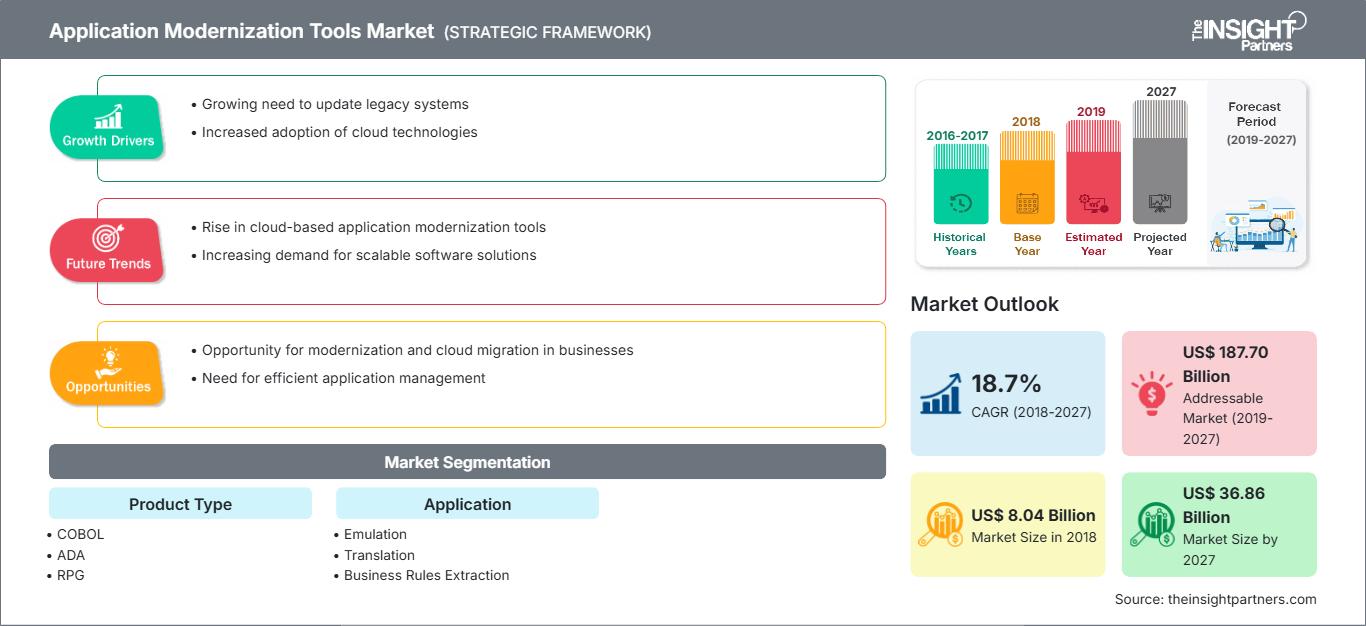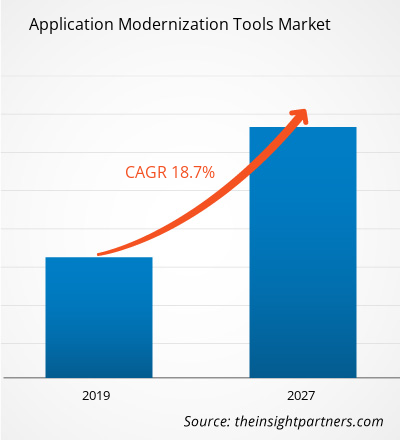Il mercato globale degli strumenti per la modernizzazione delle applicazioni ha raggiunto gli 8,04 miliardi di dollari nel 2018 e si prevede che crescerà a un CAGR del 18,7% nel periodo di previsione 2019-2027, raggiungendo i 36,86 miliardi di dollari entro il 2027.
Si prevede che il Nord America deterrà la maggiore quota di mercato degli strumenti per la modernizzazione delle applicazioni entro il 2027. I governi stanno massimizzando i propri investimenti digitali sfruttando strategicamente le nuove tecnologie, nonché i dati e l'analisi avanzata, per ottimizzare politiche e programmi e aggiornare i sistemi legacy. Migliorare e allineare i processi; attrarre nuovi investitori; introdurre un approccio intelligente basato sui dati nelle operazioni governative; fornire un migliore accesso e una migliore gestione delle informazioni; aumentare la soddisfazione e la fiducia dei cittadini; trasformare i servizi di transazione governativi; La soddisfazione delle esigenze di una demografia in rapida evoluzione e il bilanciamento dei costi, ottimizzando al contempo l'efficienza, svolgono tutti un ruolo fondamentale nella trasformazione IT in corso nei settori governativo, pubblico e privato.
Approfondimenti di mercato: la crescente trasformazione digitale in tutti i settori sta alimentando la domanda di strumenti per la modernizzazione delle applicazioni
L'ottimizzazione dei processi aziendali end-to-end, l'aumento dell'efficienza operativa, il miglioramento dell'esperienza del cliente e la riduzione dei costi sono alcuni dei fattori che guidano il mercato degli strumenti per la modernizzazione delle applicazioni. Il cambiamento di paradigma delle aziende, passando dai canali tradizionali a quelli digitali e automatizzati, si traduce in molteplici vantaggi, che vanno dal miglioramento dell'efficienza alla riduzione dei costi e all'aumento delle opportunità di fatturato, sostenendo così la crescita del mercato degli strumenti per la modernizzazione delle applicazioni.
Personalizza questo rapporto in base alle tue esigenze
Potrai personalizzare gratuitamente qualsiasi rapporto, comprese parti di questo rapporto, o analisi a livello di paese, pacchetto dati Excel, oltre a usufruire di grandi offerte e sconti per start-up e università
Mercato degli strumenti di modernizzazione delle applicazioni: Approfondimenti strategici

- Ottieni le principali tendenze chiave del mercato di questo rapporto.Questo campione GRATUITO includerà l'analisi dei dati, che vanno dalle tendenze di mercato alle stime e alle previsioni.
L'elevato grado di integrazione con altre soluzioni offre un'opportunità redditizia al mercato degli strumenti di modernizzazione delle applicazioni.
Potrai personalizzare gratuitamente qualsiasi rapporto, comprese parti di questo rapporto, o analisi a livello di paese, pacchetto dati Excel, oltre a usufruire di grandi offerte e sconti per start-up e università
Mercato degli strumenti di modernizzazione delle applicazioni: Approfondimenti strategici

- Ottieni le principali tendenze chiave del mercato di questo rapporto.Questo campione GRATUITO includerà l'analisi dei dati, che vanno dalle tendenze di mercato alle stime e alle previsioni.
Gli operatori del mercato degli strumenti di modernizzazione delle applicazioni stanno integrando diverse soluzioni con le applicazioni e il front-end su tablet, dispositivi mobili e web. Si tratta di un modo rapido ed economico per implementare nuovi processi aziendali in qualsiasi applicazione. I fornitori di servizi integrano soluzioni come l'automazione robotica dei processi (RPA), una piattaforma di automazione as-a-service. Consente di replicare l'interazione tra tecnologia e risorse umane per automatizzare un'ampia gamma di operazioni e supportare i processi in modo conveniente e aumentando l'affidabilità.
Approfondimenti sulle tipologie di prodotto
Il mercato globale degli strumenti di modernizzazione delle applicazioni per tipologia di prodotto è stato guidato dal segmento COBOL. Il processo di modernizzazione delle applicazioni è piuttosto impegnativo con i metodi tradizionali, ma con l'adozione di tecnologie agili è diventato più semplice e preciso. COBOL è un linguaggio di programmazione di alto livello che genera applicazioni completamente basate sul web e riprogetta i progetti nel rispetto dei tempi previsti, oltre a eseguire standard e seguire specifiche per un aspetto migliore, con la modernizzazione delle applicazioni .NET e Java. Diverse piattaforme disponibili sul mercato trasformano i codici esistenti in linguaggi avanzati.
Approfondimenti sulle applicazioni
Nel 2018, il mercato globale degli strumenti di modernizzazione delle applicazioni per applicazione è stato guidato dal segmento dell'emulazione. Inoltre, si prevede che questo segmento deterrà la quota di mercato più ampia entro il 2027. L'emulazione è un processo di rehosting/ripiattaforma dell'approccio di modernizzazione utilizzato per fornire un ambiente che si compila su piattaforme distribuite emulando l'ambiente operativo legacy. La capacità di emulazione riduce la quantità e le modifiche apportate al momento della migrazione del sistema legacy a una piattaforma distribuita. Il processo di emulazione offre la tecnica più rapida per migrare i carichi di lavoro da un mainframe e un modo relativamente economico e a basso rischio per ridurre i costi operativi e mantenere il valore aziendale. Si prevede che questi fattori aumenteranno la domanda di applicazioni di emulazione nel mercato degli strumenti di modernizzazione delle applicazioni.
Approfondimenti regionali sul mercato degli strumenti di modernizzazione delle applicazioni
Le tendenze regionali e i fattori che influenzano il mercato degli strumenti di modernizzazione delle applicazioni durante il periodo di previsione sono stati ampiamente spiegati dagli analisti di The Insight Partners. Questa sezione illustra anche i segmenti e la geografia del mercato degli strumenti di modernizzazione delle applicazioni in Nord America, Europa, Asia-Pacifico, Medio Oriente e Africa, America Meridionale e Centrale.
Ambito del rapporto di mercato sugli strumenti di modernizzazione delle applicazioni
| Attributo del rapporto | Dettagli |
|---|---|
| Dimensioni del mercato in 2018 | US$ 8.04 Billion |
| Dimensioni del mercato per 2027 | US$ 36.86 Billion |
| CAGR globale (2018 - 2027) | 18.7% |
| Dati storici | 2016-2017 |
| Periodo di previsione | 2019-2027 |
| Segmenti coperti |
By Tipo di prodotto
|
| Regioni e paesi coperti | Nord America
|
| Leader di mercato e profili aziendali chiave |
|
Densità degli attori del mercato degli strumenti di modernizzazione delle applicazioni: comprendere il suo impatto sulle dinamiche aziendali
Il mercato degli strumenti per la modernizzazione delle applicazioni è in rapida crescita, trainato dalla crescente domanda degli utenti finali, dovuta a fattori quali l'evoluzione delle preferenze dei consumatori, i progressi tecnologici e una maggiore consapevolezza dei vantaggi dei prodotti. Con l'aumento della domanda, le aziende stanno ampliando la propria offerta, innovando per soddisfare le esigenze dei consumatori e sfruttando le tendenze emergenti, alimentando ulteriormente la crescita del mercato.

- Ottieni il Mercato degli strumenti di modernizzazione delle applicazioni Panoramica dei principali attori chiave
Gli operatori del mercato degli strumenti di modernizzazione delle applicazioni si concentrano principalmente sul miglioramento dei prodotti attraverso l'implementazione di tecnologie avanzate. Di seguito sono elencati alcuni degli sviluppi recenti:
- 2019: Atos ha annunciato il potenziamento della piattaforma Atos Managed OpenShift (AMOS), con l'ausilio di nuove funzionalità di automazione integrate dalla piattaforma di automazione SyntBots. Questo aggiornamento è il risultato della collaborazione tra Atos e Red Hat.
- 2018: Micro Focus ha annunciato la disponibilità generale di Visual Enterprise Suite 4.0 e COBOL 4.0, segnando un passo fondamentale nell'implementazione della sua visione di trasformazione digitale per facilitare i clienti nell'aggiornamento dei processi aziendali principali e della tecnologia.
- 2017: Blu Age ha annunciato la sua partnership con Advanced, per offrire la sua soluzione rivoluzionaria: migrazione COBOL e modernizzazione dei dati ad Advanced. Con questa partnership, l'azienda offre la sua soluzione automatizzata per trasformare le sue applicazioni COBOL legacy in Java e .NET.
Segmentazione del mercato degli strumenti di modernizzazione delle applicazioni globali
Per prodotto Tipo
- COBOL
- ADA
- RPG
- Assemblatore
- PowerBuilder
- Altro
Per applicazione
- Emulazione
- Traduzione
- Estrazione di regole aziendali
Per Geografia
Nord America
- Stati Uniti
- Canada
- Messico
Europa
- Francia
- Germania
- Regno Unito
- Russia
- Italia
- Resto d'Europa
Asia Pacifico (APAC)
- Australia
- Cina
- India
- Giappone
- Corea del Sud
- Resto dell'APAC
Medio Oriente e Africa (MEA)
- Arabia Saudita
- Sudafrica
- Emirati Arabi Uniti
- Resto del MEA
Sud America (SAM)
- Brasile
- Argentina
- Resto del SAM
Profili aziendali
- Advanced Computer Software Group Limited
- Aspire Systems (India) Pvt. Ltd
- Asysco Software BV
- Atos SE
- Blu Age
- Deloitte Touche Tohmatsu Limited
- FreeSoft, Inc.
- Soluzioni per la portabilità della lingua
- Micro Focus International plc
- Mphasis Limited
- Semantic Designs, Incorporated
- SoftwareMining Technologies
- Il software Revolution Inc. (TSRI)
- Virtusa Corporation
- Analisi storica (2 anni), anno base, previsione (7 anni) con CAGR
- Analisi PEST e SWOT
- Valore/volume delle dimensioni del mercato - Globale, Regionale, Nazionale
- Industria e panorama competitivo
- Set di dati Excel
Report recenti
Testimonianze
Motivo dell'acquisto
- Processo decisionale informato
- Comprensione delle dinamiche di mercato
- Analisi competitiva
- Analisi dei clienti
- Previsioni di mercato
- Mitigazione del rischio
- Pianificazione strategica
- Giustificazione degli investimenti
- Identificazione dei mercati emergenti
- Miglioramento delle strategie di marketing
- Aumento dell'efficienza operativa
- Allineamento alle tendenze normative




















 Ottieni un campione gratuito per - Mercato degli strumenti di modernizzazione delle applicazioni
Ottieni un campione gratuito per - Mercato degli strumenti di modernizzazione delle applicazioni